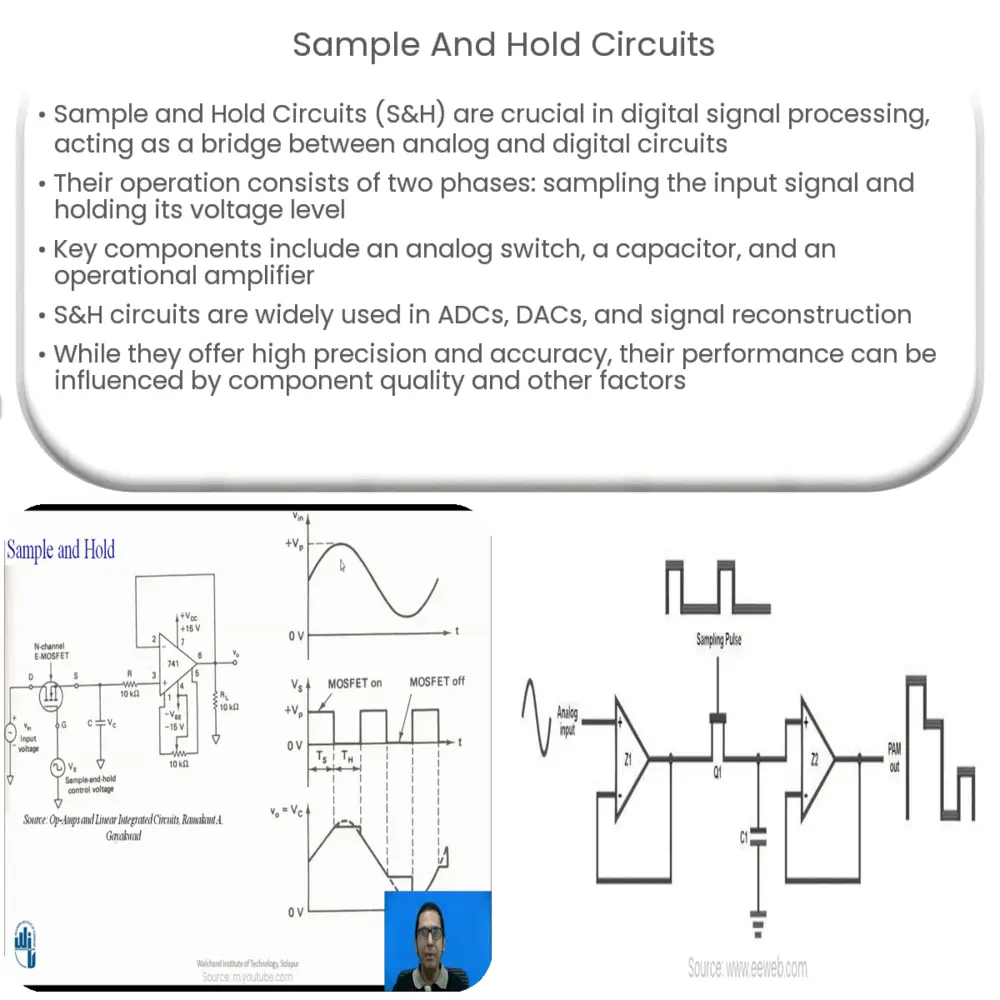Explore the basics of Sample and Hold Circuits, their operation, key components, applications, advantages, and limitations in digital signal processing systems.

Introduction to Sample and Hold Circuits
A Sample and Hold Circuit (S&H) is a fundamental building block in digital signal processing systems and data converters. It’s used extensively in analog-to-digital converters (ADCs) and digital-to-analog converters (DACs), serving as an intermediary device between analog and digital circuits.
Operation of Sample and Hold Circuits
The operation of a S&H circuit can be broken down into two distinct phases: the sample phase and the hold phase. The name “Sample and Hold” derives from this two-part operation.
- Sample Phase: During the sample phase, the input signal is connected to the capacitor through a switch. The capacitor charges or discharges to the input signal voltage. This is the “sample” part of the process as the circuit is sampling the signal.
- Hold Phase: In the hold phase, the switch is opened, disconnecting the input signal from the capacitor. The capacitor now holds onto its charge and maintains the last sampled voltage. This is the “hold” part of the process.
These two phases are usually controlled by a clock signal that dictates when to sample and when to hold. The frequency of this clock signal determines how often the analog signal is sampled.
Key Components of Sample and Hold Circuits
A typical S&H circuit is built using a few essential components:
- Analog Switch: An analog switch is used to connect and disconnect the input signal to the circuit. During the sample phase, the switch is closed, and during the hold phase, it’s opened.
- Capacitor: The capacitor is the component that samples and holds the signal. It charges to the voltage level of the input signal when the switch is closed and maintains the charge when the switch is opened.
- Operational Amplifier: An op-amp in a unity gain configuration (also known as a voltage follower) is often used to buffer the output. It provides a high impedance load to the capacitor, ensuring that it doesn’t discharge prematurely.
Understanding these basic elements and their functions within the circuit is essential for comprehending how S&H circuits work and their role in signal processing systems.
Applications of Sample and Hold Circuits
Sample and Hold circuits find widespread usage across various fields in the realm of digital electronics and signal processing. Let’s explore some of these applications:
- Analog-to-Digital Converters (ADCs): In ADCs, S&H circuits are used to sample an analog signal before it is converted into a digital signal. The S&H circuit captures and freezes the analog signal at a particular instant, making it easier for the ADC to process.
- Digital-to-Analog Converters (DACs): In DACs, a S&H circuit is used in a slightly different way. The digital signal is first converted to an analog signal, and then the S&H circuit is used to maintain the signal level for a specified period of time.
- Signal Reconstruction: S&H circuits can be used in reconstructing signals that have been subjected to distortion or interference.
Advantages and Limitations
Sample and Hold circuits offer a variety of benefits, making them instrumental in digital signal processing. They allow the conversion and processing of signals without significant loss of information. However, like all electronic components, they also have some limitations:
- Advantages: S&H circuits offer high precision and accuracy in signal processing, making them critical in areas such as communication systems, medical electronics, and instrumentation.
- Limitations: The performance of S&H circuits can be affected by factors such as switch resistance, leakage currents, and capacitor charge leakage (also known as droop). Moreover, the circuit’s performance is dependent on the quality of the components used, particularly the capacitor and the switch.
Conclusion
In conclusion, Sample and Hold circuits are a vital component of digital signal processing systems, serving as a bridge between the analog and digital worlds. Their ability to capture and maintain an analog signal’s level for a given period has wide-ranging applications, from ADCs and DACs to signal reconstruction. While they come with their limitations, their advantages make them indispensable in modern electronics.
As technology advances, the performance and efficiency of these circuits are continually being improved, broadening the scope of their applications. Thus, a solid understanding of Sample and Hold circuits not only aids in appreciating the current state of electronic systems but also in envisaging their future developments.

